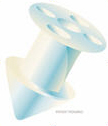Dry Eye Syndrome (Keratoconjunctivitis Sicca) affects many people and is due to either a deficiency in tear production or an increase in tear evaporation. Clinical presentation varies widely, from mild tearing and foreign body sensation to severe ocular discomfort leading to keratopathy and potential visual compromise. Conservative therapy includes use of
artificial tears and other pharmacologic drops, warm compresses and lid hygiene. When a case is too severe to be managed in this way, more aggressive measures must be taken.
Punctal plugs are often used in refractory cases of dry eyes in order to occlude the tear drainage opening to increase the staying power of the tear film. There are permanent punctal plugs as well as synthetic dissolvable plugs that are placed into the canaliculus. I prefer to use the permanent punctal plugs that have a lip to situate them at the punctal opening. The advantages are the ease of placement and removal in the case of patient discomfort or infection. As well, the risk of canaliculitis is decreased with punctal plugs as some intracanalicular plugs can be associated with atypical mycobacteria, among other bacteria. The following discusses a few of the punctal plugs that I use most often.
FCI Ophthalmics
Snug Plugs™

Silicone Snug Plugs™ are preloaded in a stretched position and return to their natural shape when inserted into the punctum. They are packaged with 2 preloaded plugs per box and are one size fits all.
"Ready-Set" Punctum Plugs

“Ready-Set” silicone plugs have a slanted lip to conform to the natural shape of the eyelid. As well, they are preloaded on a disposable inserter/dilator and are easily removed if needed. These plugs come in 7 different sizes, ranging from Slim Mini (0.4mm) to Large (1mm).
TearSaver Plugs

These silicone plugs have a tapered shaft to keep the plug in place. They are also preloaded on disposable inserter/dilators.
Alcon Laboratories
Tears Naturale Plugs

Tears Naturale punctal plugs are manufactured by Alcon. These are easy to insert or remove behind the slit lamp without anesthesia or just with application of topical proparacaine and in very little time. They are preloaded on disposable inserter/dilators and come in various sizes.
AlphaMed
AquaFlo Plugs

AquaFlo Plugs have unique reservoir indentations in the dome, trapping tears thereby reducing foreign body sensation. They come in 4 sizes.
Eagle Vision®
Eagleplug®
This is the original tapered shaft plug made by Eagle Vision®. It is very easy to insert behind the slit lamp and can as well be removed with relative ease behind the slit lamp. It comes in various sizes, starting as small as 0.4mm.
Supereagle® Punctal Plug
This plug is a more advanced silicone plug with a low profile rim and soft material, adding to patient comfort. This plug also has a tapered shaft and comes in 3 sizes.
Eagle Vision also makes a Flow Controller Plug that has a lumen in the center for partial occlusion.
Intracanalicular Plugs
Eagle Vision, Oasis Medical, Odyssey Medical, Medennium, Surgical Specialties (Angiotech) and Lacrimedics are among the companies producing dissolvable intracanalicular plugs, such as the Smart Plug, Herrick Plug, FormFit Plug, SoftPlug, Ultraplug and Duraplug. As well, Lacrimedics makes a silicone intracanalicular plug called the Herrick Plug.
As mentioned above, I prefer the non-absorbable punctal plugs that have a lip that positions them at the lid margin. This allows easy insertion as well as easy removal if the patient should have complications, such as discomfort or infection. The lip decreases the risk that the plug dislodges into the canaliculus or further into the nasolacrimal duct, which can be associated with an atypical mycobacterial infection. These preloaded silicone plugs can be placed in the clinic with either no anesthesia or just topical anesthetic applied with a cotton tip applicator. The opposite end of the disposable inserter is a dilator that can be used prior to placement of the plug. If removal is needed, again, behind the slit lamp or with loupes, the plug can be easily removed with a pair of fine-toothed forceps.
Punctal plugs can be very effective in advanced dry eye patients. By occluding the punctum they increase the tear film and help to reduce the risk of keratopathy due to exposure. They seem to overall be well tolerated and when fitted properly, stay positioned offering patients lasting relief of their dry eye symptoms.